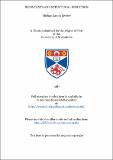Files in this item
Bicontexts and structural induction
Item metadata
| dc.contributor.advisor | Cole, A. J. (Alfred John) | |
| dc.contributor.author | Livesey, Mike | |
| dc.coverage.spatial | 185 p. | en_US |
| dc.date.accessioned | 2018-05-23T09:10:01Z | |
| dc.date.available | 2018-05-23T09:10:01Z | |
| dc.date.issued | 1987 | |
| dc.identifier.uri | https://hdl.handle.net/10023/13483 | |
| dc.description.abstract | This thesis introduces and explores the notion of bicontext, an order-enriched category equipped with a unary endofunctor of order two called reverse. The purpose is threefold. First, the important categories that arise in Scott-Strachey denotational semantics have this additional structure, where by the constructions used to solve "data-type equations" are both limits and colimits simultaneously. Second, it yields a pleasant "set-theoretic" treatment of algebraic data-types in terms of bicontexts of (1, 1) relations rather than pairs of continuous functions. The theory provides a general way of relating bicontexts which serves to connect these particular ones. Third, the least solutions of data-type equations often have an associated principle of structural induction. Properties in such solutions become arrows in the appropriate bicontext, making the defining functor directly applicable to them. In this way the structural induction can be derived systematically from the functor. | en_US |
| dc.language.iso | en | en_US |
| dc.publisher | University of St Andrews | |
| dc.subject.lcc | QA76.9D35L5 | |
| dc.subject.lcsh | Data structures (Computer science) | en |
| dc.title | Bicontexts and structural induction | en_US |
| dc.type | Thesis | en_US |
| dc.type.qualificationlevel | Doctoral | en_US |
| dc.type.qualificationname | PhD Doctor of Philosophy | en_US |
| dc.publisher.institution | The University of St Andrews | en_US |
This item appears in the following Collection(s)
Items in the St Andrews Research Repository are protected by copyright, with all rights reserved, unless otherwise indicated.

